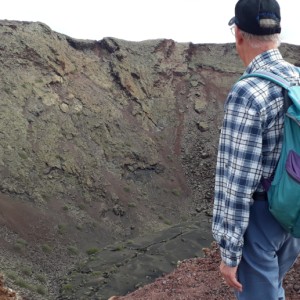In parts of Scotland, especially not far from where we live, there is much evidence of ancient volcanic activity with the former volcanic cones, calderas, sills and dykes and igneous rocks. I was interested in seeing a more recent volcanic landscape so we decided to seek some warmth by going to Lanzarote for a week.
While it is not a very attractive landscape it was very interesting to examine more fully the rocks and volcanic landforms on one of our hikes. Here the last eruptions took place between 1730 and 1736 and vegetation is slowly covering some of the rocks and soils. Today we were led on a nine kilometre traverse by a volcanologist who explained the differences of the various parts and the colours of soils which were predominately black but also had grey, orange and yellow tones. The main photo shows the end of the walk after we had passed over the nearby volcanic ashes and sands scattered with large volcanic bombs and then we crossed the hard rough stony ”a’a” rocks and undulating “pahoehoe” lava flows seen in the middle distance before approaching the distant peak. We had to ensure that we stayed on the very narrow track because in places the surface was very fragile with deep fissures. The extra is of the Montana Santa Catalina crater, so named after the village which had been covered by the erupting volcano. Fortunately the inhabitants had time to escape to the safer coast.

Comments
Sign in or get an account to comment.


